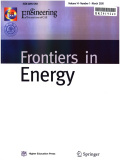Optimization of spatial structure designs of control rod using Monte Carlo code RMC
基本信息来源于合作网站,原文需代理用户跳转至来源网站获取
摘要:
Control rod is the most important approach to control reactivity in reactors,which is currently a cluster of pins filled with boron carbide(B4C).In this case,neutrons are captured in the outer region,and thus the inner absorber is inefficient.Moreover,the lifetime of the control rod is challenged due to the high reactivity worth loss resulted from the excessive degradation of B4C in the high flux area.In this work,some control rod designs are proposed with optimized spatial structures including the spatially mixed rod,radially moderated rod,and composite control rod with small-sized pins.The control rod worth and effective absorption cross section of these designs are computed using the Monte Carlo code RMC.A long-time depletion calculation is conducted to evaluate their burnup stability.For the spatially mixed rod,rare-earth absorbers are combined with B4C in spatial structure.Compared with the homogenous B4C rod,mixed designs ensure more sufficient reactivity worth in the lifetime of the reactor.The minimum reactivity loss at the end of the cycle is only 1.8%from the dysprosium titanate rod,while the loss for pure B4C rod is nearly 12%.For the radially moderated design,a doubled neutronic efficiency is achieved when the volume ratio of moderator equals approximately 0.3,while excessive moderating may lead to the failure of control rods.The control rod with small-sized pins enhanced by introducing small moderator pins,and the reactivity loss caused by the reduction of absorbers is sustainable.

推荐文章
Monte-Carlo统计迭代图像重建算法
层析γ扫描
线性衰减系数
Monte-Carlo方法
图像重建
迭代法
Spatial analysis of carbon storage density of mid-subtropical forests using geostatistics: a case st
Carbon storage density
Geostatistics
Mid-subtropical forests
Spatial autocorrelation
Spatial heterogeneity
Monte Carlo方法在气体动理论中的应用
Monte Carlo方法
气体动理论
麦克斯韦速率分布
改进Monte Carlo算法用于RFID标签的室内定位
通信技术
无线定位
Monte Carlo定位算法
RFID室内定位系统
内容分析
关键词云
关键词热度
相关文献总数
(/次)
(/年)
引文网络
引文网络
二级参考文献 (0)
共引文献 (0)
参考文献 (0)
节点文献
引证文献 (0)
同被引文献 (0)
二级引证文献 (0)
2021(0)
- 参考文献(0)
- 二级参考文献(0)
- 引证文献(0)
- 二级引证文献(0)
引文网络交叉学科
相关学者/机构
期刊影响力
能源前沿
主办单位:
高等教育出版社
出版周期:
季刊
ISSN:
2095-1701
CN:
11-6017/TK
开本:
出版地:
北京市朝阳区惠新东街4号富盛大厦15层
邮发代号:
创刊时间:
语种:
eng
出版文献量(篇)
843
总下载数(次)
1
总被引数(次)
1099
期刊文献
相关文献
推荐文献
- 期刊分类
- 期刊(年)
- 期刊(期)
- 期刊推荐

 免费查重
免费查重










